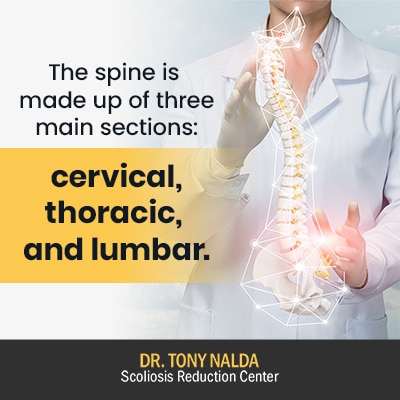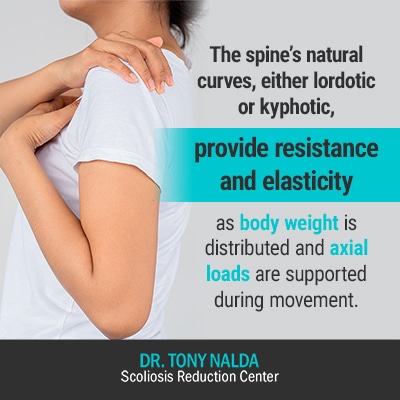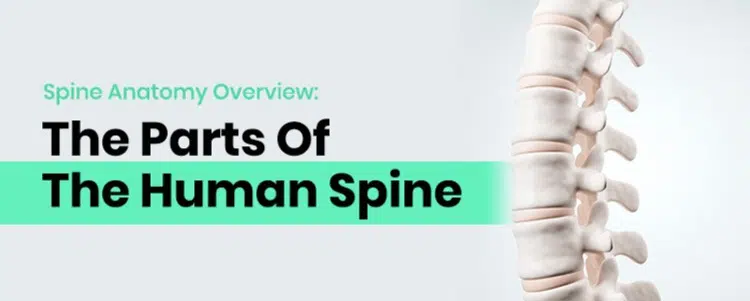The human spine helps us to stand upright, practice good posture, balance, and move around. In addition, it works in tandem with the brain to form the body’s central nervous system (CNS), through which important messages pass between the brain and the rest of the body. A better understanding of spinal anatomy can lead to proactive choices that promote the spine’s health and function.
The human spine consists of three main sections: cervical, thoracic, and lumbar. Each spinal section has its own healthy curvature. For preserving the spine’s overall health and function, maintaining those curves is important, and the vertebrae and intervertebral discs play integral roles.
As such a key component of human anatomy, the spine has many important parts and functions. Let’s take a look at some basic spinal anatomy for a better understanding of how to protect the spine.
4 Key Takeaways
- Spinal Anatomy and Health: A deep understanding of spinal anatomy, including the three main sections—cervical, thoracic, and lumbar—and their corresponding curvatures, is fundamental to making proactive health choices that support spinal health and function.
- Importance of Spinal Curves: Maintaining the spine’s natural curvatures is essential for its strength, flexibility, and ability to distribute stress. Awareness of how these curves are supported by the vertebrae and intervertebral discs can guide spine-friendly lifestyle choices.
- Proactive Treatment for Spinal Conditions: Early detection and proactive treatment of spinal conditions, such as scoliosis, are crucial. Treatment is more straightforward and potentially more effective when started early, before significant progression occurs.
- Lifestyle Choices for Spinal Health: Active living, proper posture, and hydration are key lifestyle choices that support spinal health. These habits help prevent deterioration of critical spinal structures like intervertebral discs, preserving spinal biomechanics and overall well-being.
Sections of the Spine

The spine is made up of three main sections: cervical, thoracic, and lumbar. The cervical spine refers to the neck; the thoracic spine includes the middle and upper back, while the lumbar spine includes the lower back.
Each section has a corresponding curvature, which is why when viewed from the front and/or back, the spine appears straight, but when viewed from the side, it has a soft ‘S’ shape.
The spine is naturally curved because it makes it stronger, more flexible, and facilitates the even distribution of weight and stress that occurs during movement, and this is important because a variety of common spinal conditions involve a loss of the spine’s healthy curves.
There are two main types of curvatures, based on whether they bend forwards, towards the body’s center in a soft ‘C’ shape, or backwards, away from the body’s center in a reverse ‘C’ shape; the term ‘lordosis’ refers to the spine’s curvatures that bend backwards, away from the body’s center, while ‘kyphosis’ refers to a forward-bending curve.
The cervical and lumbar spine features lordotic curves, with a healthy cervical lordosis ranging between 20 and 40 degrees and a healthy lumbar lordosis ranging from 40 to 60 degrees; a healthy kyphotic curve of the thoracic spine ranges between 20 and 40 degrees.
As you can see, even in a healthy spine, there is a natural curvature range, but when spinal curves fall beyond that healthy range, this indicates the presence of a spinal condition that can cause problems in the future, especially if left untreated, or not treated appropriately.
Now that we have talked about the three main spinal sections, let’s talk about the main component that makes up these sections: vertebrae.
The Bones of the Spine: Vertebrae
The bones of the spine are known as ‘vertebrae’, and in a healthy spine, these bones are rectangular in shape and stacked on top of one another in a straight, neutral, and natural alignment.
Each spinal section houses a certain number of vertebrae. The cervical spine includes 7 vertebrae and are abbreviated as C1 – C7; the thoracic spine includes 12 and are abbreviated as T1 – T12, and the lumbar spine has 5, abbreviated as L1 – L5.
Cervical Vertebrae
The cervical spine is further divided into two sections: the upper cervical region with the C1 and C2 vertebrae and the lower cervical region with the remaining C3 to C7 vertebrae.
C1 is referred to as the ‘atlas’, while C2 forms the ‘axis’. The atlas (C1) is the first cervical vertebra, and this cervical vertebra supports the weight of the skull. The second cervical vertebra, axis (C2), is referred to as the ‘dens’ or ‘odontoid process’ and acts as a type of pivot and collar, allowing the head and atlas to rotate around the dens so the head can be moved from side to side, up and down, and forward and back.
The cervical vertebrae are the smallest of the spine.
Thoracic Vertebrae
The thoracic vertebrae include T1 – T12 and increase in size from 1 to 12. These vertebrae join with the rib cage but don’t attach at T11 and T12, which is why these ribs are referred to as ‘floating ribs’.
The thoracic vertebrae have long spinous processes, which are the bumps of the spine that you can see and feel if you run your fingers down the length of the spine, and it’s the many connections between the ribs and vertebrae, along with the long spinous processes, that limit the thoracic spine’s range of motion.
Lumbar Vertebrae
The lumbar vertebrae (L1 – L5) also get larger from 1 to 5, and these vertebrae bear the brunt of the body’s weight and related biomechanical stress, which is why lower back pain is such a common complaint.
The lumbar vertebrae are the largest of the spine.
While not commonly included in discussions of the spine’s main sections, there is also the sacral spine, which the lumbar spine connects with.
The sacral spine includes 5 vertebrae, abbreviated as S1 – S5, and these vertebrae are fused together into a triangular shape (sacrum). The sacrum rests between the two hip bones that connect the spine to the pelvis.
The last lumbar vertebra (L5) moves with the sacrum, and below the sacrum are 5 additional vertebrae, fused together to form the coccyx, commonly known as the ‘tailbone’.
So now that we have talked about the number and characteristics of vertebrae that make up each of the spine’s main sections, let’s explore the actual purpose of the vertebrae.
Why the Vertebrae are Important
The vertebrae perform many important functions that preserve the spine’s overall health and function. Vertebral bodies are the weight-bearing structures of the spine as upper body weight is absorbed throughout the spine.

The spine’s natural curves, either lordotic or kyphotic, provide resistance and elasticity as body weight is distributed and axial loads are supported during movement.
The bones of the spine are made up of many different parts, all of which are critical when it comes to maintaining the spine’s optimal function.
The vertebrae make up the vertebral column, also commonly referred to as ‘spinal column’, and help protect the spinal cord and its nerve roots, along with providing protection for several internal organs.
The spinal column also serves as a base for the attachment of ligaments, tendons, and muscles, thus providing structural support for the head, shoulders, and chest. It also connects the upper body to the lower body and facilitates balance and weight distribution.
The vertebral column also facilitates flexion (bending forward) and extension (bending backward), bending from side to side, rotating, and being able to combine these different types of movement.
The vertebrae of the spine are also important because, as bones, they produce red blood cells and store minerals, which is important for oxygen transport throughout the body.
Another important part of the spine are the discs that sit between adjacent vertebrae: intervertebral discs.
The Spine’s Intervertebral Discs
The intervertebral discs sit between adjacent vertebrae, with the exception of C1 and C2, and account for one fourth of the spine’s entire length.
The spine’s intervertebral discs are important not just in terms of what they do, but also how much they are relied upon by other parts of the spine, like the vertebrae.
The intervertebral discs have two main parts: a tough and durable outer layer and a soft gel-like interior.
The discs act as the spine’s shock absorbers, protecting the vertebrae, brain, muscles, and nerves. The discs facilitate vertebral motion such as extension and flexion, and although individual disc movement is limited, when multiple discs combine forces, they can facilitate a considerable amount of motion.
The durable outer layer provides the spine with structure and attachment points for the vertebrae, while the gel-like interior helps facilitate vertebral movement.
Both the annulus fibrosus (tough outer layer) and nucleus pulposus (gel-like interior) are made up of water, collagen, and proteoglycans (PGs). The nucleus pulposus holds the highest concentration of water and PGs, which is important because the discs don’t have their own vascular supply.
Through healthy movement and staying hydrated, the discs can replenish themselves to an extent, but if they become overly sedentary and/or dehydrated, they can lose height as their ability to perform optimally is impaired; this not only impacts the health of the discs themselves, but the entire spine as the vertebrae are also affected.
When the intervertebral discs start to degenerate, the spine’s ability to maintain its curvatures and alignment is compromised, and this can lead to the development of a number of spinal conditions.
So now that we have discussed the spine’s main sections, its corresponding curvatures, and how the spine’s individual parts work together to preserve its function, what happens when a spinal condition with the potential to disrupt that spinal function develops?
Spinal Conditions and the Spine’s Structure
As discussed, the spine is curved for important reasons, and we know that the spine relies on its different parts to help maintain those natural and healthy curvatures, but what happens when there is a loss of those healthy curves?
There are many spinal conditions a person can develop that involve a loss of its healthy curves and a misaligned spine.
When a structural condition develops, this means it is caused by an abnormality within the spine itself, and in order to be treated effectively, the condition has to be impacted on a structural level.
Let’s take scoliosis, for example; according to the National Scoliosis Foundation, there are close to seven million people currently living with scoliosis in the United States alone, and keep in mind, these estimates only include known diagnosed cases.
Scoliosis is an abnormal sideways curvature of the spine, with rotation, that also meets a Cobb angle requirement of 10+ degrees.
Curvature size is measured during X-ray and involves drawing lines from the tops and bottoms of the most-tilted vertebrae of the curvature: at its apex. The resulting angle is measured in degrees and places the condition on its severity level of mild, moderate, severe, or very severe:
- Mild scoliosis: Cobb angle measurement of between 10 and 25 degrees
- Moderate scoliosis: Cobb angle measurement of between 25 and 40 degrees
- Severe scoliosis: Cobb angle measurement of 40+ degrees
- Very-severe scoliosis: Cobb angle measurement of 80+ degrees
As you can see, just as there is a natural range within a healthy spinal curvature, there is also a large range within unhealthy spinal curvatures.
While every case is different with its own unique treatment needs, generally speaking, the higher the Cobb angle, the more severe the condition, the more likely it is to produce noticeable symptoms such as pain (more common in adults), and postural changes.
As scoliosis, and a number of other spinal conditions, is progressive, this means if left untreated, or not treated appropriately, the curvature will increase over time, which is why proactive treatment is so important.
Here at the Scoliosis Reduction Center®, I offer patients an integrative and chiropractic-centered treatment approach that works towards a curvature reduction on a structural level, plus increasing the strength of the spine and its surrounding muscles so it is better supported and stabilized.
When it comes to protecting the health and function of the spine, in addition to healthy lifestyle habits such as leading an active life, maintaining a healthy weight, practicing good posture, and lifting heavy objects properly, if there are signs that a spinal condition like scoliosis has developed, seeking proactive treatment is always the right decision.
While treatment results are never guaranteed, there are numerous treatment benefits associated with early detection, but only if an appropriate course of proactive treatment is applied; it’s far simpler to treat a curvature before it has progressed significantly, while it is still small, is less rigid, and before the body has had time to adjust to its presence.
Here at the Center, I start treatment as close to the time of diagnosis as possible in order to spare patients the hardships associated with reaching higher stages of progression and needing more invasive treatment down the road.
Conclusion
When it comes to understanding spine anatomy, the knowledge can help guide decisions that protect the spine’s overall health and function.
For example, once the role and structure of the intervertebral discs is understood, the decision to be more active, maintain a healthy weight, and stay hydrated can help prevent disc deterioration, which not only protects the discs themselves, but the entire spine and its biomechanics.
As each spinal section has a corresponding healthy curvature, a loss of its healthy curves can affect any section: cervical, thoracic, and/or lumbar.
Understanding not only why the spine is curved, but also how the spine maintains those curves can lead to spine-friendly lifestyle choices, and positive choices to seek proactive treatment when changes to the spine and/or related postural changes develop.
In children and adolescents, the majority of spinal conditions are not painful because they are still growing, and the lengthening motion of a growing spine counteracts the compressive force of the curvature; in adults, however, condition-related back pain is far more common as skeletal maturity has been reached, making the spine and its surroundings vulnerable to compression caused by the unnatural spinal curve.
In fact, it’s most often pain that brings adults in for a diagnosis and treatment.
So to summarize, the spine has three main sections, each with a characteristic healthy curvature, and the spinal column itself consists of vertebrae that are stacked on top of one another in a neutral and healthy alignment, separated by intervertebral discs.
As the very design of the spine is movement-oriented, staying active to promote spinal health is important, as is seeking professional guidance/treatment when signs of a developing spinal condition are present.
In order for the spine to perform optimally, it needs to maintain its natural and healthy curvatures and alignment. Stretching and staying active can help keep the spine and its surrounding muscles as loose as possible, and this helps protect the spine by increasing core strength so the spine is better supported and stabilized.
If you, or someone you care about, is experiencing unexplained back and/or muscle pain and/or postural changes, reaching out to us here at the Scoliosis Reduction Center® could be the first step towards a diagnosis and the benefits of proactive treatment.





